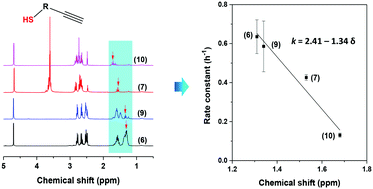The electrophilic effect of thiol groups on thiol–yne thermal click polymerization for hyperbranched polythioether†
Abstract
This paper firstly revealed the electrophilic effect of thiol groups on thiol–yne polymerization. For this, we designed and synthesized five kinds of α-thiol-ω-alkynyl AB2 type intermediates with thiols with different electrophilicities. The thiol electrophilic effect can be assessed by chemical shift (δ) and measured directly by nuclear magnetic resonance (NMR) spectroscopy. As the evidence from gel permeation chromatography (GPC) and NMR tracking measurements shows, the polymerization rate and molecular weight (MW) were significantly enhanced as the thiol electrophilic effect reduced. On the contrary, with increasing electrophilicity of the thiol, the resultant degrees of branching (DBs) increased. The semiquantitative relation between reactive rate constant (k) and δ (or electrophilicity of thiol) can be expressed by k = 2.41–1.34δ. Therefore, important features of thiol–yne polymerization and HPTEs, such as rate constant (k), MW, DB, etc., can be roughly estimated in advance by the NMR measurement of the thiol's electrophilic effect.


 Please wait while we load your content...
Please wait while we load your content...